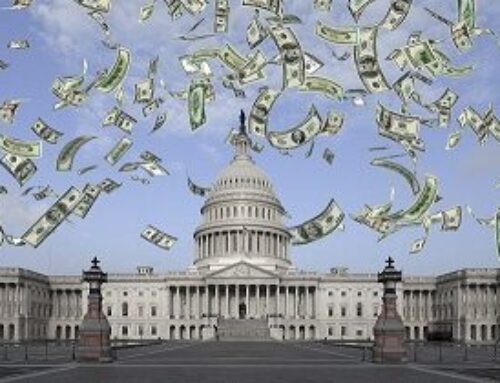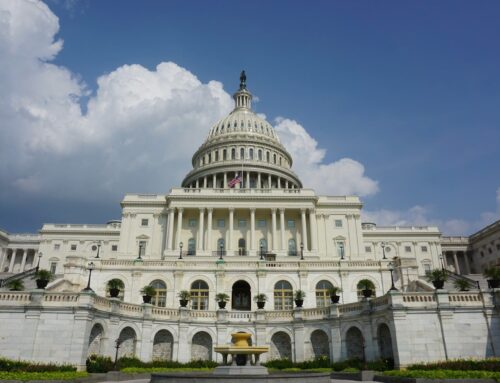The Biden Administration’s long-awaited infrastructure plan contains roughly $2.2 trillion in spending proposals across a broad swath of traditional and newly defined “infrastructure.” The 25-page plan is big on ideas and short on details. Official Congressional Budget Office (CBO) calculations, or educated guesses by TCS, of the plan’s price tag may become available as the plan transforms into actual legislative language. In the meantime, below is a summary of the top line spending as presented by the administration.
$621 billion for transportation and resilience:
- $115 billion for road and bridge modernization
- 20,000 miles of roads
- Most economically significant bridges
- 10,000 smaller bridges
- $20 billion for “vision zero” “to reduce crashes and fatalities, especially for cyclists and pedestrians”
- $85 billion for mass transit
- $80 billion for passenger and freight rail
- $174 billion in electric vehicle (EV) investment (tax breaks, rebates, electrification of the postal service fleet, etc.)
- $25 billion for airports
- $17 billion for Inland Waterways (IW), ports, ferries, and land ports
- $20 billion to bring equity to past transportation projects
- $25 billion for regional or national projects outside regular funding formula
- $50 billion on infrastructure resilience
- Federal Emergency Management Agency (FEMA) building resilient infrastructure, Community Development Block Grants (CDBG), and tax credits for relocation
- Nature-based infrastructure
$111 billion for drinking water, $100 billion electric grid, and $100 billion for broadband
- $45 billion on lead water pipe remediation – Drinking Water State Revolving Fund and Water Infrastructure Improvements for the Nation Act (WIIN) Act grants
- $56 billion in loans and grants for drinking water, wastewater, and stormwater
- $10 billion focused on per- and polyfluoroalkyl substances (PFAS) monitoring and remediation in rural America, including private wells
- $100 billion for broadband investment
- $100 billion to move toward carbon free electricity by 2035
- Several priorities, including $16 billion to cap orphaned oil wells and abandoned mines and another $10 billion for Civilian Conservation Corps
- Several priorities, including $16 billion to cap orphaned oil wells and abandoned mines and another $10 billion for Civilian Conservation Corps
Build, preserve, and retrofit homes, schools, Veteran’s Affairs (VA), Federal buildings
- $213 billion for homes
- Produce, preserve, and retrofit more than 1 million housing units
- $20 billion to build and rehabilitate 500,000 homes for low and middle income communities through the Neighborhood Homes Investment Act
- Eliminate exclusionary zoning
- $40 billion for Public Housing Capital infrastructure
- $27 billion for a new Clean Energy and Sustainability Accelerator
- Unspecified: $126 billion. Likely part of the 1 million housing units and other programs where costs were not included in this summary document
- $100 billion for public school upgrades
- $12 billion for Community Colleges
- $25 billion for childcare facilities – directly constructing and tax credits for construction
- $18 billion for VA modernization of facilities
- $10 billion for modernization, sustainability, and resilience of federal buildings – creates a Federal Capitol Revolving Fund
“Solidify infrastructure of our care economy”
- $400 billion to expand access to quality, affordable home or community-based care for aging relatives and people with disabilities
- Expand access to home and community-based services (HCBS) and extend the longstanding Money Follows the Person program
- Policies to facilitate creation of union jobs
R&D, manufacturing, etc – $180 billion
- $50 billion for the National Science Foundation – technology directorate
- $30 billion for R&D that produces innovation and jobs in rural areas
- $40 billion for research laboratory infrastructure
- $20 billion is reserved for Historically Black College or University (HBCUs) – new national lab on climate to be affiliated with an HBCU
- $35 billion in full range of solutions to achieve tech breakthroughs on climate
- Includes funding for the Advanced Research Projects Agency-Climate (ARPA-C) “to develop new methods for reducing emissions and building climate resilience”
- $5 billion increase for other climate-focused research
- $15 billion in demonstration projects for “climate R&D priorities, including utility-scale energy storage, carbon capture and storage, hydrogen, advanced nuclear, rare earth element separations, floating offshore wind, biofuel/bioproducts, quantum computing,
and electric vehicles.”
- $10 billion R&D investment in HBCUs and other Minority Serving Institutions (MSIs)
- $15 billion to create up to 200 centers of excellence serving research incubators at HBCUs and MSIs
$300 billion to retool and revitalize American manufacturers and small businesses (aka Make American Manufacturing Great Again)
- $50 billion for new Dept. of Commerce office to manage industrial capacity and fund investments in critical goods
- $50 billion for semiconductor research and manufacturing
- $30 billion for future pandemics – national stockpile, therapeutics, etc. (the American Rescue Plan already provided $10 billion)
- $46 billion in federal procurement to jumpstart clean energy manufacturing, including “advanced nuclear reactors and fuel,” electric vehicles, charging ports, electric heat pumps, etc.
- “Make it in ALL of America” section
- $20 billion for regional innovation hubs and a Community Revitalization Fund
- $14 billion for the National Institute of Standards and Technology (NIST)
- Quadruple support for the Manufacturing Extensions Partnership
- $52 billion investment in domestic manufacturers
- Extending the 48C tax credit program (historically around $2 billion over ten years)
- $31 billion on small business incubators
- $5 billion on the Rural Partnership Program
$100 billion to invest in workforce development
- $40 billion for new Dislocated Workers Program and sector-based training
- $12 billion for workforce development opportunities in underserved communities
- $5 billion over 8 years for community violence prevention programs
- $48 billion for workforce development infrastructure and worker protection
Other workforce reforms
- Calls on Congress to pass the Protecting the Right to Organize (PRO) Act
- Various labor policies
- Increased penalties when employers violate workplace safety and health rules
Made in America Tax Plan
The administration includes a number of proposed changes to the tax code to offset the costs of its spending proposal. These changes are all focused on corporate taxes, not on individual income tax rates or policies.
$2 trillion in tax code changes: Plan estimates corporate tax changes will raise over $2 trillion over the next 15 years to pay for jobs plan’s one-time investments and eventually reduce the deficit as well
- Set the corporate tax rate at 28 percent
- (2017 tax cut law reduced the top corporate tax rate to 21 percent from its pre-2017 level of 35 percent)
- Change global minimal tax for U.S. multinational corporations
- “Increase the minimum tax for U.S. corporations to 21 percent and calculate it on a country-by-country basis so it hits profits in tax havens”
- “Eliminate the rule that allows U.S. companies to pay zero taxes on the first 10 percent of return when they locate investments in foreign countries”
- Minimize use of foreign tax havens
- “Denies deductions to foreign corporations on payments that could allow them to strip profits out of the United States if they are based in a country that does not adopt a strong minimum tax.”
- “Replaces an ineffective provision in the 2017 tax law that tried to stop foreign corporations from stripping profits out of the United States”
- Proposal to make it more difficult for U.S. corporations to invert/move headquarters to another country to avoid taxation
- Eliminate tax deductions for companies offshoring jobs and introduce a tax credit for onshoring jobs
- Elimination of tax incentives for Foreign Derived Intangible Income (FDII), with revenue used to expand R&D
- 15 percent minimum tax on the income corporations use to report their profits to investors, known as “book income”
- Eliminate special tax preferences for the fossil fuel industry
- Restoration of pollution payments into the Superfund Trust Fund
- “Broader enforcement initiative to be announced in the coming weeks that will address tax evasion among corporations and high-income Americans”
Photo Credit: Mario Mantel via Flickr











Get Social